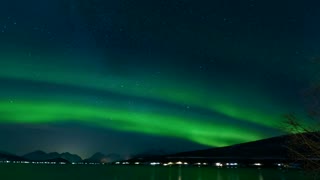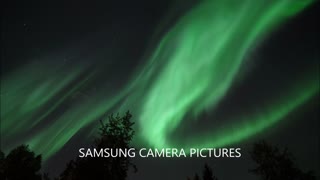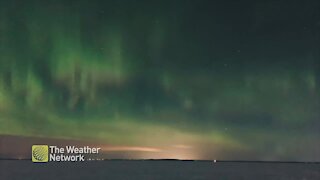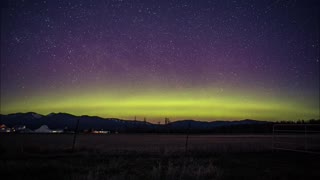Premium Only Content

The Stunning Aurora Borealis Northern Lights
An aurora is a natural light display that shimmers in the sky. Colourful blue, red, yellow, green, and orange lights shift gently and change shape like softly blowing curtains. Auroras are only visible at night, and usually only appear in lower polar regions.
Auroras are visible almost every night near the Arctic and Antarctic Circles, which are about 66.5 degrees north and south of the Equator. In the north, the display is called aurora borealis, or northern lights. In the south, it is called aurora australis, or southern lights.
Auroras and the Solar Wind
The activity that creates auroras begins with the sun. The sun is a ball of superhot gases made up of electrically charged particles called ions. The ions, which continuously stream from the sun’s surface, are called the solar wind.
As the solar wind approaches the Earth, it meets the Earth’s magnetic field. Without this magnetic field protecting the planet, the solar wind would blow away Earth’s fragile atmosphere, preventing all life. Most of the solar wind is blocked by the magnetosphere, and the ions, forced around the planet, continue to travel farther into the solar system.
Although most of the solar wind is blocked by the magnetosphere, some of the ions become briefly trapped in ring-shaped holding areas around the planet. These areas, in a region of the atmosphere, called the ionosphere, are centered around the Earth’s geomagnetic poles. The geomagnetic poles mark the tilted axis of the Earth’s magnetic field. They lie about 1,300 kilometres (800 miles) from the geographic poles but are slowly moving.
In the ionosphere, the ions of the solar wind collide with atoms of oxygen and nitrogen from the Earth’s atmosphere. The energy released during these collisions causes a colourful glowing halo around the poles—an aurora. Most auroras happen about 97-1,000 kilometres (60-620 miles) above the Earth’s surface.
The most active auroras happen when the solar wind is the strongest. The solar wind is usually fairly constant, but solar weather—the heating and cooling of different parts of the sun—can change daily.
Solar weather is often measured in sunspots. Sunspots are the coldest part of the sun and appear as dark blobs on its white-hot surface. Solar flares and coronal mass ejections are associated with sunspots. Solar flares and coronal mass ejections are sudden, extra bursts of energy in the solar wind. Sunspot activity is tracked over an 11-year cycle. Bright, consistent auroras are most visible during the height of sunspot activity.
Some increased activity in the solar wind happens during every equinox. These regular fluctuations are known as magnetic storms. Magnetic storms can lead to auroras being seen in the midlatitudes during the time around the spring and autumnal equinoxes. Auroras have been visible as far south as the Yucatan Peninsula in Mexico.
Magnetic storms and active auroras can sometimes interfere with communications. They can disrupt radio and radar signals. Intense magnetic storms can even disable communication satellites.
Colouring an Aurora
The colours of the aurora vary, depending on altitude and the kind of atoms involved. If ions strike oxygen atoms high in the atmosphere, the interaction produces a red glow. This is an unusual aurora—the most familiar display, a green-yellow hue, occurs as ions strike oxygen at lower altitudes. Reddish and bluish light that often appears in the lower fringes of auroras is produced by ions striking atoms of nitrogen. Ions striking hydrogen and helium atoms can produce blue and purple auroras, although our eyes can rarely detect this part of the electromagnetic spectrum.
Thanks for supporting my video, if you enjoyed this short video clip and are excited for more amazing videos.
-
 1:37
1:37
Expert Videos Magnetic Media
3 years agoDolphin kisses a little girl and brings her a gift
47044 -
 0:04
0:04
RelaxingAndChillOutMusic
3 years ago $0.01 earnedAurora Borealis Timelapse Video - Northern Lights
32 -
 0:12
0:12
Alaska Journey Tours in Fairbanks
3 years ago $0.01 earnedStunning Northern Lights Chasing in Fairbanks, Alaska in August
73 -
 0:35
0:35
Pelmorex_Eng
4 years agoNorthern lights dazzle in stunning timelapse
44 -
 0:25
0:25
ViralHog
3 years ago $0.13 earnedStunning Aurora Borealis Dances Across Star Filled Sky
5194 -
 LIVE
LIVE
Randi Hipper
36 minutes agoTrump’s Crypto Takeover: Reserve Reveal Stuns All!
261 watching -
 58:30
58:30
Kyle Fortch
1 hour agoCadillac Dale: #1 Song With Jack Harlow, Rihanna Sampling His 90s Hit,
1 -
 LIVE
LIVE
SternAmerican
21 hours agoIntegrity in Action call With Steve Stern and Raj Doraisamy Monday, March 3rd at 10:00AM EST
265 watching -
 LIVE
LIVE
Jeff Ahern
1 hour ago $0.82 earnedMonday Madness with Jeff Ahern (6am Pacific)
454 watching -
 16:55
16:55
Clownfish TV
14 hours agoThe Oscars Just Jumped the Shark...
33K13